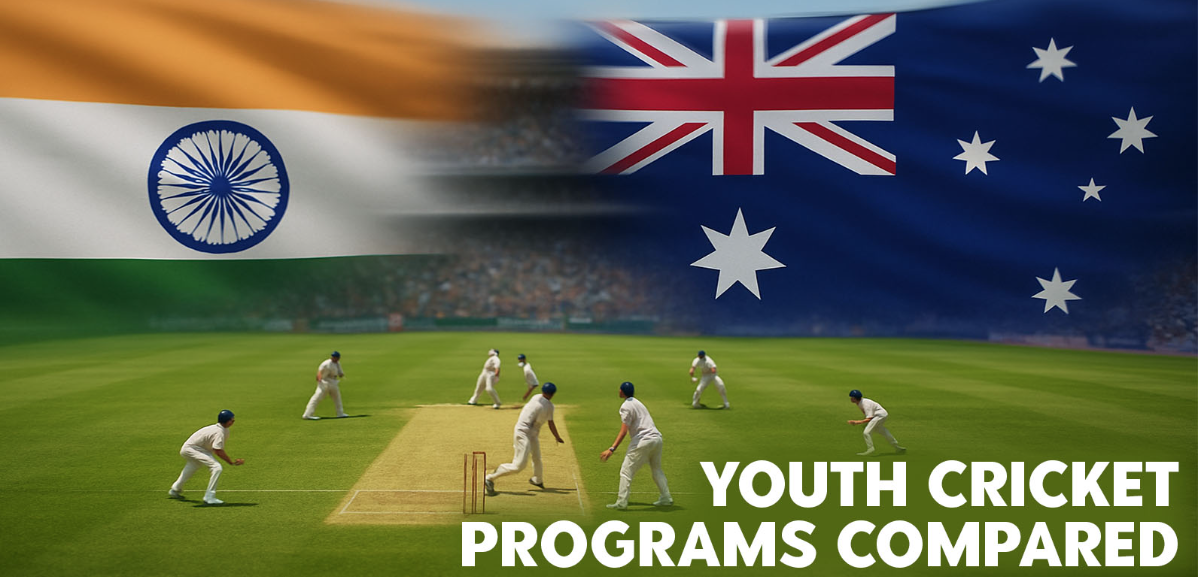Youth Cricket Programs Compared: India vs Australia

Cricket remains one of the world’s most beloved sports, with India and Australia standing as two powerhouses that have consistently produced world-class talent. Both nations have developed sophisticated youth cricket programs that serve as the backbone of their international success. But which country has created the superior training system for nurturing young cricketers?
This comprehensive comparison examines the youth cricket development systems in India and Australia, analysing everything from grassroots infrastructure to professional pathways. By exploring coaching methodologies, facilities, talent identification processes, and long-term player development strategies, we’ll uncover the strengths and weaknesses of each approach.
Whether you’re a cricket enthusiast, coach, parent, or young player considering the sport’s future landscape, understanding these contrasting philosophies offers valuable insights into what makes cricket excellence possible. As part of the broader cricket landscape in India, a 1xBet review in India is published, focusing on responsible, adult-only betting.
Cricket Culture and Grassroots Development
India’s cricket culture runs deeper than sport — it’s a national obsession that permeates every level of society. Children begin playing cricket in streets, parks, and makeshift grounds across the country, creating an enormous talent pool. The Board of Control for Cricket in India (BCCI) has capitalised on this enthusiasm by establishing programs that reach rural and urban areas alike.
The Indian Premier League’s (IPL) massive success has further amplified grassroots interest, with local leagues and school competitions multiplying rapidly. State cricket associations organise age-group tournaments that provide structured pathways from district to national levels.
Australia approaches grassroots development differently, focusing on quality over quantity. Cricket Australia’s community cricket programs emphasise fun, skill development, and modified formats like T20 Blast and Junior League Cricket. The Australian system benefits from excellent school sport integration and strong club structures that have operated for decades.
Australian cricket culture values the “fair dinkum” approach — honest effort, sportsmanship, and resilience. This cultural foundation shapes how young players are developed, with emphasis on character building alongside technical skills.
Structure of Youth Cricket Programs
India’s youth cricket structure operates through a complex network of state associations, each managing their own age-group programs. The Under-16, Under-19, and Under-23 categories provide clear progression pathways, with national tournaments like the Cooch Behar Trophy and Vinoo Mankad Trophy serving as stepping stones.
The National Cricket Academy (NCA) in Bengaluru represents the pinnacle of Indian youth development, offering world-class facilities and coaching for promising players. Additionally, private academies and coaching centres have proliferated across the country, creating multiple development pathways.
Australia’s structure appears more streamlined, with Cricket Australia overseeing a unified national pathway system. The National Cricket Championships provide a clear tournament structure, whilst state academies work in coordination with Cricket Australia’s National Cricket Centre.
The Australian system particularly excels in its integration between school cricket, club cricket, and representative pathways. This coordination ensures fewer talented players slip through cracks in the system.
Coaching Standards and Methodologies
Indian coaching has evolved dramatically over recent decades, moving from traditional methods towards more scientific approaches. The BCCI has invested heavily in coach education programs and brought international expertise to the NCA.
However, coaching quality varies significantly across India’s vast geography. Metropolitan areas enjoy access to qualified coaches and modern methodologies, whilst rural regions may still rely on traditional approaches. The sheer volume of aspiring cricketers can sometimes result in inadequate coach-to-player ratios.
Australia maintains consistently high coaching standards through Cricket Australia’s comprehensive coach education program. The Australian Cricket Coaches’ Association ensures ongoing professional development and standardised methodologies across the country.
Australian coaching philosophy emphasises technical fundamentals, mental resilience, and tactical awareness. The smaller player pool allows for more individualised attention and detailed skill development.
Facilities and Infrastructure
India’s infrastructure development has accelerated significantly, particularly in major cities. State-of-the-art facilities like the NCA, various IPL venues, and private academies provide excellent training environments. However, infrastructure quality remains inconsistent across different regions.
The climate advantage cannot be understated — year-round cricket is possible across most of India, maximising training opportunities. Indoor facilities and artificial pitches are increasingly common in urban areas.
Australia boasts exceptional infrastructure standards, with world-class facilities distributed across all states. The Allan Border Field in Brisbane, Centre of Excellence in Adelaide, and numerous high-quality grounds provide outstanding training environments.
Australian facilities often feature advanced technology, including video analysis systems, bowling machines, and biomechanics laboratories. The infrastructure may be less extensive than India’s, but it maintains consistently high standards.
Talent Identification and Scouting
India’s talent identification benefits from the massive playing population and extensive tournament structure. State associations conduct regular trials and tournaments that expose talented players to higher levels of competition. The IPL has revolutionised talent identification, with franchises investing heavily in scouting networks that reach previously untapped regions. This professional approach has uncovered gems from smaller towns and cities.
Australia employs a more systematic talent identification approach through the National Talent Pathway. Regular assessments, performance tracking, and holistic player evaluation ensure promising cricketers receive appropriate development opportunities. The smaller population means Australian scouts must be more efficient and thorough in their identification processes. This has led to sophisticated assessment methods that consider technical skills, athletic ability, and psychological factors.
Transition to Professional Cricket

India’s pathway to professional cricket can be challenging due to intense competition. Players must excel through state cricket, potentially Indian Premier League opportunities, and domestic competitions like the Ranji Trophy. The recent introduction of age-group IPL tournaments has created additional professional pathways, though the transition remains highly competitive. Success often depends on connections, regional politics, and maintaining form over extended periods.
Australia’s transition pathway appears more structured and merit-based. State cricket contracts, Big Bash League opportunities, and Sheffield Shield cricket provide clear stepping stones to international representation. The Australian system’s smaller scale allows for closer monitoring of individual player development and more personalised transition support.
Challenges and Areas for Improvement
Both systems face distinct challenges that affect their effectiveness. India struggles with inconsistent infrastructure, varying coaching quality, and managing the enormous talent pool efficiently. Regional disparities and administrative complexities can hinder optimal player development.
Australia faces challenges related to declining participation rates and increased competition from other sports. Geographic isolation affects some regional areas, whilst the smaller talent pool means fewer opportunities to find exceptional players. Both countries must address modern challenges like mental health support, injury prevention, and balancing traditional cricket values with contemporary demands.
Who Trains Better? A Balanced View
Determining which country trains better depends on the metrics used. India excels at producing a large pool of skilled players and achieving success across all formats, with new stars emerging regularly. Australia consistently develops high-quality players known for technical skills and mental toughness. Their structured system and excellent infrastructure help most players reach their potential. Rather than declaring one system superior, it’s clear both succeed in their contexts — India leverages its population and passion for cricket, while Australia maximises limited resources through superior organisation and infrastructure.
Conclusion
Ultimately, both India’s and Australia’s youth cricket programs exemplify the diverse paths to nurturing cricketing talent. India’s expansive system thrives on its massive player base and cultural fervor, creating opportunities for hidden talents to shine, while Australia’s streamlined and methodical approach produces technically proficient and resilient players. Rather than pitting one against the other, recognising the unique strengths of each system offers valuable lessons. Both nations demonstrate that different strategies can achieve the shared goal of fostering world-class cricketing excellence.
